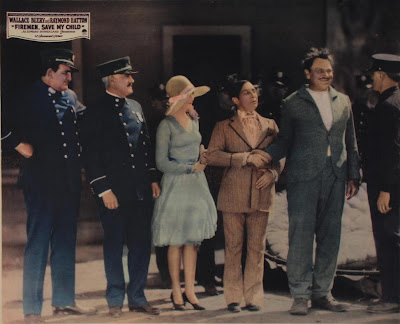It is not possible for a comedy routine to survive for hundreds of years without being highly adaptive and, trust me, a routine has passed the stringent test for adaptability if it has been performed effectively by comedians as unlike as Harold Lloyd and the Three Stooges. The Stooges' clowning was, without a doubt, different from the tidily constructed comedy presented by Lloyd. Looks, alone, could tell you that these were entirely different species of funnymen. Lloyd looks like a normal, upright fellow.
And this is how the Stooges look.
The Stooge characters, who lack enterprise and forethought, have very little in common with the clever, bespectacled go-getter made popular by Lloyd. It makes it especially complicated to take a routine performed by a single comedian and adapt it to an insanely oddball triumvirate of comedians. Yet, many time-tested routines were performed by both Lloyd and the Stooges. Of course, some of the comic business shared by these men was simple, standard stuff.
Are Crooks Dishonest? (1918)
The Ghost Talks (1949)
A scared reaction is a scared reaction. But, other times, their joint routines were more elaborate. Take, for example, the gramophone routine. Early versions of the routine were featured in Polidor's Gramophone (1912) and Canned Harmony (1912). The plot of Canned Harmony is set into motion by the rebellious daughter of a music professor. The professor insists that the daughter marry a gifted musician, but the daughter has fallen in love with a man lacking in musical ability and is willing to deceive her father to gain his consent to marry. The father is enthusiastic to meet his daughter's suitor because he expects the man to demonstrate his mastery of the violin. The daughter, who has carefully planned the meeting, operates a hidden gramophone as her suitor pretends to play.
Canned Harmony (1912)
The father realizes only moments before the wedding that he has been duped, but he cheerfully allows the ceremony to continue.
A similar scenario turned up forty-one years later on The Abbott & Costello Show ("The Music Lover," 1953). Of course, the scene has several of Abbott & Costello's burlesque touches. This time, the father (Raymond Hatton) is not as engaged by the music as he is by a smelly loaf of salami. Also, the routine does not end on a happy note.
For Harold Lloyd's The Non-Stop Kid (1918), the plot of Canned Harmony was altered to make the suitor the driving force behind the hoax. In this reconfiguration, the daughter is reduced to a decidedly passive role. Mr. Wiggle (William Blaisdell) insists that his daughter (Bebe Daniels) marry noted music professor M. T. Noodle. Lloyd, who is attracted to the daughter, knocks the professor unconscious so that he can impersonate the man at the Wiggle family's tea social. When called to sing before the guests, Lloyd persuades a sympathetic butler (Snub Pollard) to play a gramophone in a hidden alcove while he pretends to sing.
Lloyd's charade ends when the real Professor Noodle shows up to the party. The father chases Lloyd out of his home, but Lloyd manages to double back for Miss Wiggle. In the film's closing moments, the couple summon a taxi to elope.
The plot of Canned Harmony was given a more modern slant in the Stooges' Micro-Phonies (1945). A daughter (Christine McIntyre) rebels against her father, Mr. Bixby (Sam Flint), not to marry an eager suitor but to pursue a singing career. As usual, the Stooges accept a job although they lack the prerequisite skills to accomplish the job. This time, the boys have to do more than pretend they know the business end of a wrench. Curly, dressed in drag, poses as singing sensation Señorita Cucaracha to perform at a swank party hosted by Mrs. Bixby. The plan is for Curly to lip-sync to a record playing on a hidden gramophone, but Moe gets angry with Curly and impulsively breaks the record over his head. McIntyre steps forward to help the Stooges. She hides behind a curtain and sings while Curly mouths the words. The ruse is exposed, but Mr. Bixby is so enchanted by his daughter's singing that he sets aside the misgivings he has about his daughter's career ambitions.
A unique twist on this premise was provided in The Ladykillers (1955). The daughter has been replaced by a gang of thieves, the disapproving father has been replaced by a disapproving landlady, and the suitor has been replaced by bagloads of stolen banknotes.
Additional note
Raymond Hatton, who played Hillary Brooke's father in the Abbott & Costello scene, was a veteran character actor who had appeared in nearly 500 films. Hatton first achieved popularity when he was paired with Wallace Beery for a series of military comedies - Behind the Front (1926), We're in the Navy Now (1926) and Now We're in the Air (1927). Hatton played a slickster opposite Beery's sap. The team of Beery and Hatton was, as this basic description suggests, a precursor to Abbott and Costello. It was bad luck for Costello to have gotten himself caught between Abbott and Hatton, neither of whom would hesitate to dupe or generally abuse a person as gullible as he was.
Beery and Hatton made seven feature films between 1926 and 1928.
Behind the Front (1926)
We're in the Navy Now (1926)
Now We're in the Air (1927)
Fireman, Save my Child (1927)
Partners in Crime (1928)
The Big Killing (1928)
Wife Savers (1928)
Hatton later starred with John Wayne and Ray Corrigan in the Republic Pictures series The Three Mesquiteers.
Wyoming Outlaw (1939)
I will close today's blog post with a clip from Abbott & Costello's Hit the Ice (1943).

































.jpg)






No comments:
Post a Comment